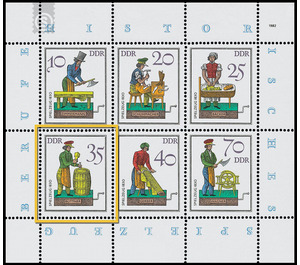Commemorative stamp series - Germany / German Democratic Republic 1982 - 35 Pfennig
Theme: Post & Philately
| Country | Germany / German Democratic Republic |
| Issue Date | 1982 |
| Face Value | 35.00 |
| Color | multi-colored |
| Perforation | K 14 |
| Printing Type | offset |
| Stamp Type | Postage stamp |
| Item Type | Stamp |
| Chronological Issue Number | 2503 |
| Chronological Chapter | GER-DDR |
| SID | 576498 |
| In 11 Wishlists | |
Historical Toys - Professions The depictions of historic toy figures around 1830 depicting occupations, the Ministry of Posts and Telecommunications of the German Democratic Republic issued six multicolored special postage stamps. No special first day cover envelope Special cancellation from 23rd November 1982 to 22nd January 1983 Historical Toys - Professions The motives for the postage stamp issue "Historical Toy Professions" have been taken from the toy pattern book of the Sonneberger publisher and merchant Johann Simon Lindner from 1831, the the publishing house edition Leipzig 1979 in a reprint has issued. This model book belongs to the collection of toy pattern books from the period from 1830 to the end of the 19th century, which counts about 60 specimens and which the toy museum Sonneberg has to look after as a particularly valuable collection. No other source can provide such a comprehensive overview of the variety of products of the Sonneberg toymaker of the time as this collection of sample books; but the number of original toys, which has come down to us today and is kept in museums and collections, is small. Even the figures depicted on the six special postage stamps, which show artisans with the tools typical of their profession at work, have not been preserved in the original. In addition to the pictures we have, price lists from the 1930s are telling about these toy figurines. Such a directory is called "simple and double blacksmiths, masons, carpenters, carpenters, wood splitters, pigsticks ... and all only required craftsmen, sounding and moving, extrafein the piece to 15 cruisers". The artisan figures, made from papier-mâché and wood, stand on a wooden box containing a simple mechanism that can be operated by a side-mounted crank. The movement mechanism was usually associated with a simple musical work that consisted of tense gut or wire strings. The Büttner on the 35-Pfennig-Wertzeichen belongs to a formerly strongly represented in the southern Thuringian forest areas occupational group, which produced barrels and other containers for daily needs. The toy boy is evidently busy opening the iron barrel hoops. The clothes of all craftsmen shows characteristics of the Biedermeier period. Paper mache toys, to which the six "professionals" - as the figurative representations of occupation were also called in contemporary sources in Sonneberg - were particularly characteristic of the nineteenth-century Sonneberg toy industry. In the first decades of the nineteenth century, the pulpy mass, which consisted mainly of soaked paper waste and was processed with the aid of gypsum and sulfur forms, replaced wood, the hitherto most important material for toy production, and enabled the transition to mass production , The Sonneberg toy industry had gifted modellers and skilful bosses who could react very quickly to the change of fashion trends. For their patterns, they used contemporary image templates, portraits of well-known personalities, caricatures, fashion and traditional costumes, as well as genre depictions, which also include graphics that we have not previously seen, with scenes from the work of artisans. Beyond their function as toys, our "Professionals" are therefore charming testimonials from the world of craft work.


